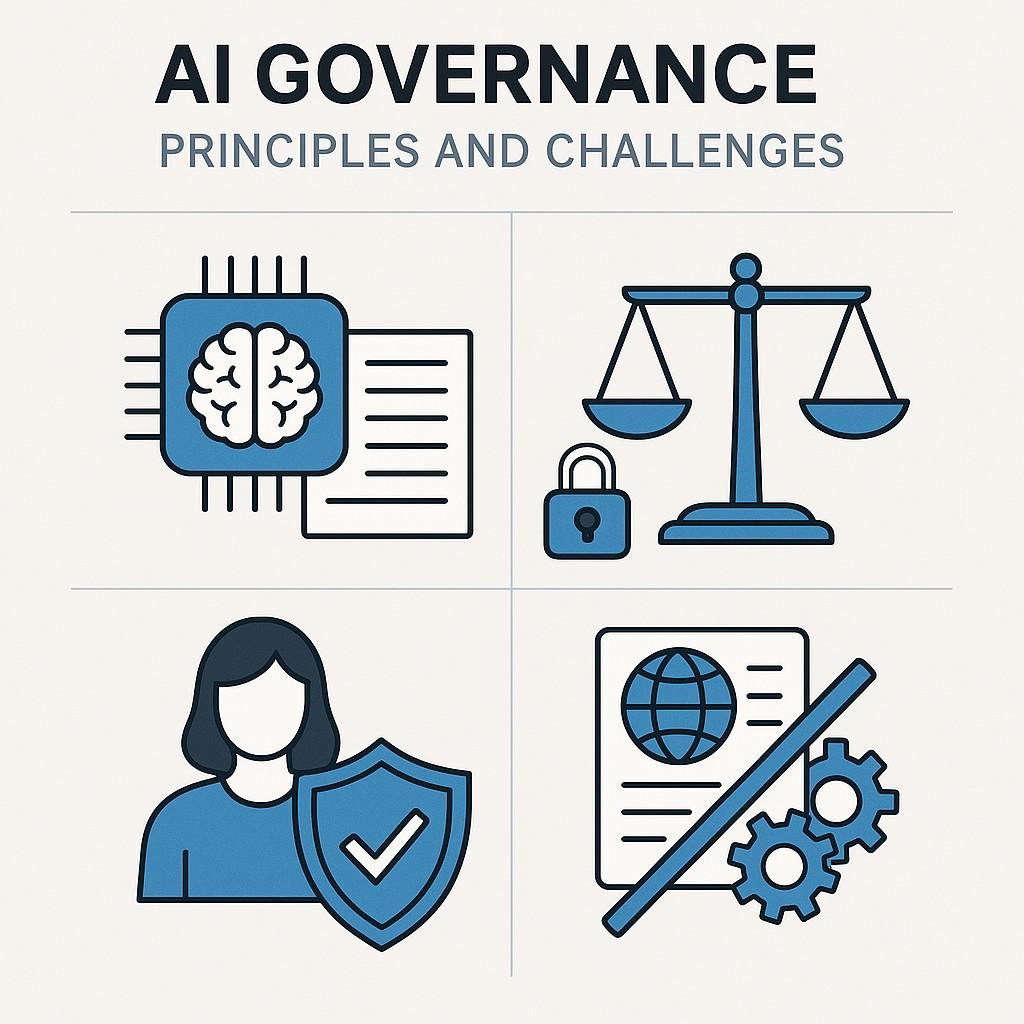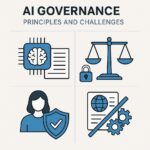Definition of AI Governance
AI Governance refers to the frameworks, policies, and practices designed to ensure the responsible development, deployment, and use of Artificial Intelligence (AI) system. It involves setting guidelines that address ethical, legal, and societal implications to ensure AI aligns with human values, fairness, and accountability.
Key Components of AI Governance
- Ethical Principles – Establishing guidelines for fairness, transparency, and non-discrimination to prevent biases in AI systems.
- Regulatory Compliance – Ensuring adherence to laws, regulations, and industry standards related to AI use.
- Accountability and Responsibility – Defining clear ownership of AI decisions and responsibilities for AI decisions and responsibilities for AI failure or biases.
- Transparency and Explainability – Transparency in AI refers to the ability to understand how AI systems work, encompassing the data they are trained on, the algorithms they employ, and the decision-making processes they follow. Explainability, a closely related concept, focuses on providing clear and understandable reasons behind specific AI outputs or decisions, allowing humans to comprehend why a particular outcome was reached. Together, transparency and explainability are crucial for building trust in AI systems, ensuring accountability, and enabling effective human oversight, particularly in sensitive domains like healthcare, finance, and criminal justice, while also facilitating the identification and mitigation of potential biases and errors.
Importance of AI Governance – AI Governance is crucial for building in AI technologies by ensuring that AI systems are used responsibly and ethically. Proper governance helps mitigate risks such as biased decision-making, data misuse, and security threats. It also promotes innovation by providing a structured framework for AI development, balancing progress with ethical considerations.
Challenges in AI Governance
- Lack of Global Standards – Varying regulations across different regions create inconsistencies.
- Rapid Technological Advancements – AI evolves quickly, making it difficult for governance frameworks to keep up.
- Complexity of AI Systems – Understanding and auditing AI decision-making can be challenging.
- Balancing Innovations and Regulation – Striking a balance between encouraging AI development and ensuring responsible use.
- Bias and Discrimination – AI systems can perpetuate and amplify existing societal biases present in the data they are trained on, leading to unfair or discriminatory outcomes in areas like hiring, loan applications, and even criminal justice. Ensuring fairness and equity in AI is a significant challenge.
- Privacy and Data Protection – AI systems often rely on vast amounts of data, including personal information. Ensuring the privacy and security of this data, and regulating its collection, storage, and use in AI applications, is crucial but complex, especially with cross-border data flows.
Importance of AI Governance in the Modern World – As AI continues to integrate into various aspects of society, AI Governance has become increasingly critical. AI Governance establish the policies, frameworks, and ethical guidelines necessary to ensure AI systems are developed and used responsibly, minimizing risks while maximizing benefits.
Ensuring Ethical and Responsible Use – AI systems can make autonomous decisions with significant impacts on individuals and society. Without proper governance, there’s a risk of AI being used in ways that infringe upon privacy, perpetuate biases, or even cause harm. AI governance frameworks ensure that AI systems adhere to ethical principles and legal guidelines, promoting fairness, transparency, and accountability.
Building and Maintaining Trust – Trust is fundamental for the widespread adoption of AI. AI governance helps build and maintain this trust by ensuring that AI systems are reliable, secure, and their decision-making processes are understandable. Transparency in how AI systems work and accountability for their outcomes are key elements in fostering confidence among users, businesses, and the public.
Mitigating Risks and Ensuring Safety – AI technologies, while powerful, can also pose significant risks, including security vulnerabilities, data breaches, and the potential for unintended consequences. AI governance frameworks help identify, assess, and mitigate these risks through established protocols, security measures, and continuous monitoring, ensuring the safety and reliability of AI systems.
Promoting Compliance and Avoiding Legal Issues – As governments worldwide begin to implement AI-related regulations, AI governance frameworks help organizations ensure compliance with these evolving legal landscapes. By establishing clear guidelines and audit mechanisms, businesses can avoid hefty fines and legal disputes, demonstrating their commitment to responsible AI practices.
Driving Innovation and Economic Growth – While providing necessary oversight, effective AI governance can also foster innovation by creating a clear and predictable environment for AI development and deployment. By establishing guidelines for data access, sharing, and ethical experimentation, governance frameworks can encourage responsible technological advancement and unlock the economic potential of AI.
Addressing Bias and Promoting Fairness – The “black box” nature of some AI models can hinder understanding and trust. AI governance emphasizes transparency and explainability, making the workings of AI systems more accessible and understandable to stakeholders. This allows for better scrutiny, identification of errors, and increased accountability.
Facilitating Collaboration and Standardization – AI governance encourages collaboration among diverse stakeholders, including developers, policymakers, and the public, to shape the future of AI responsibly. It also promotes the development of standards and best practices, fostering interoperability and comparability across AI systems.
In conclusion, AI governance is not merely a set of rules but a crucial framework for navigating the complexities and opportunities of the AI era. It is essential for ensuring that AI benefits society as a whole, while mitigating its risks and upholding ethical values. As AI continues to evolve, so too must our approaches to its governance, requiring ongoing dialogue, adaptation, and collaboration across all sectors.
Key Stakeholders in AI Governance – AI Governance involves multiple stakeholders who play crucial roles in ensuring the ethical, legal, and responsible use of artificial intelligence. These stakeholders contribute to policy-making, implementation, oversight, and the development of AI technologies, ensuring they align with societal values and regulations.
1. Governments and Regulatory Bodies:
Role: Setting laws, regulations, standards, and guidelines for AI development and deployment. They aim to protect citizens’ rights, ensure fair competition, and mitigate risks associated with AI.
Responsibilities: Drafting AI-specific legislation (like the EU AI Act), establishing regulatory agencies or task forces, monitoring compliance, and enforcing AI-related laws.
Examples: National governments (e.g., India’s Ministry of Electronics and Information Technology), international bodies (e.g., the OECD, UNESCO), and regional organizations (e.g., the European Union).
2. AI Developers and Researchers:
Role: Designing, building, and testing AI systems. They are at the forefront of technological innovation and have a direct impact on the capabilities and limitations of AI.
Responsibilities: Implementing ethical considerations in the design process, ensuring data quality and security, striving for transparency and explainability in their models, and adhering to industry best practices and standards.
Examples: AI research labs in universities and corporations, individual AI engineers, and data scientists.
3. Businesses and Industry:
Role: Developing, deploying, and using AI technologies for various applications, driving economic growth and efficiency.
Responsibilities: Adopting responsible AI practices, ensuring compliance with regulations, addressing potential biases in their AI systems, being transparent about their AI usage, and considering the societal impact of their AI deployments.
Examples: Tech companies (developing AI products), businesses across sectors (using AI for automation, customer service, etc.), and industry consortia.
4. End Users and the Public:
Role: Interacting with and being affected by AI systems in their daily lives. Their trust and acceptance are crucial for the widespread adoption of AI.
Responsibilities: Providing feedback on AI systems, demanding transparency and accountability, raising concerns about potential harms or biases, and engaging in public discourse about AI ethics and governance.
Examples: Consumers using AI-powered services, individuals whose data is used to train AI, and the general citizenry impacted by AI-driven decisions.
5. Civil Society Organizations and Advocacy Groups:
Role: Representing the interests of specific groups (e.g., minorities, consumers) and advocating for ethical and responsible AI development and deployment.
Responsibilities: Raising awareness about potential AI risks and biases, lobbying for stronger regulations, conducting research on the societal impact of AI, and providing a voice for marginalized communities.
Examples: AI ethics non-profits, consumer protection agencies, and human rights organizations.
6. International Organizations:
Role: Facilitating international cooperation on AI governance, developing global standards and principles, and addressing the transnational challenges posed by AI.
Responsibilities: Promoting dialogue and harmonization of AI regulations across countries, establishing ethical guidelines with international consensus, and supporting capacity building in AI governance for developing nations.
Examples: The United Nations (UN), the Organization for Economic Cooperation and Development (OECD), and the International Telecommunication Union (ITU).
The effective governance of AI requires active engagement, communication, and collaboration among all these stakeholders. Their diverse perspectives and expertise are essential for creating a balanced and comprehensive framework that fosters innovation while mitigating the risks and ensuring the benefits of AI are shared by all.





